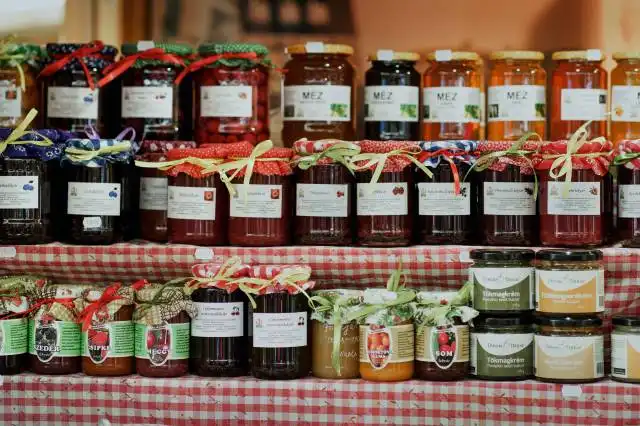Start a Coffee Roasting Business
Unlocking the Symphony of Flavors in Coffee Roasting
| Updated


COFFEE ROASTING BUSINESS
Embark on the aromatic journey of starting a Coffee Roasting business, where you serve as the maestro, coaxing out the captivating symphony of flavors hidden within each humble coffee bean. This venture is all about sourcing raw, unroasted coffee beans and using heat to bring about their full, savor-filled potential. As a now-launched coffee crusader, you'll not only command the cozy, irresistible smells of a morning brew but will also delve into the intriguing science behind how those notes are created. So, gear up for a thrilling ride in this business where your laboratory is a roaster, and the result - a perfect cup of Joe!
Jump to Business Plan
RELATED BUSINESS IDEAS
Browse ALL Food & Beverage Entrepreneurship Business Ideas
Discover Your Perfect Domain
Unlock the door to your online success with our hand-picked selection of premium domain names. Whether you're starting a new venture or rebranding an existing one, the right domain can set the tone for your digital presence. Browse through our curated list, each with its unique potential to enhance your brand's visibility and credibility.
COFFEE ROASTING MINI BUSINESS PLAN
This a quick reality check to help you identify the strengths and weaknesses of your business concept before you dive in.
Expected Percent Margin:
- Gross Margin: 60-70%
- Net Profit Margin: 10-20%
Earnings Expectations:
- Daily Earnings: $300 - $600
- Weekly Earnings: $2,100 - $4,200
- Monthly Earnings: $9,000 - $18,000
- Annual Earnings: $108,000 - $216,000
Actions to Hit Those Numbers:
Market Research
- Understand your target audience; their taste preferences, buying behavior and price point.
Sourcing Beans
- Developing strong relationships with reliable coffee bean suppliers.
- Choose a variety of beans to cater a range of tastes.
Buying Roasting Equipment
- Be prepared to invest in high-quality coffee roasting equipment.
Roasting Process
- Learn the art of roasting; each bean type requires a specific roasting technique.
Packaging and Branding
- Invest in attractive, airtight packaging to maintain freshness.
- Strong branding to make your business stand out.
Pricing Strategy
- Reflect your costs and efforts in your pricing but remain competitive.
Marketing and Sales
- Have consistent online and offline presence.
- Offer samples or cup tasting to prospective customers.
- Consider selling online and in local markets.
Delivery and Distribution
- Ensure timely delivery.
- Find wholesalers or retailers for larger distribution.
Customer Service
- Offer excellent customer service; happy customers become repeat customers.
Keep in mind, these are rough estimates and can fluctuate based on location, economic factors, and individual business strategies. Always seek the advice of a trusted financial advisor for more tailored advice.
NOT WHAT YOU HAD IN MIND? Here are more ideas



Browse ALL Food & Beverage Entrepreneurship Business Ideas
Grab Your Business Website Name
Before you get caught up in the whirlwind of setting up your business, invest in a domain name. It's a small but significant step that lays the foundation for your brand and makes it easier for customers to find and trust you. Just like you wouldn't build a house without securing the land first, don't build a business without securing your domain name.
"Why? Can't that wait?" Here's why it shouldn't
Step 1: Determine if the Business is Right for You
Starting a coffee roasting business requires a significant investment of time and money. Before taking the plunge, it is important to determine if the business is the right endeavor for you. To do this, you should first create a breakdown of startup expenses. This should include the cost of the roaster, green coffee beans, packaging materials, and any other equipment you may need. Additionally, you should create a breakdown of ongoing expenses, such as the cost of green coffee beans, electricity, and labor.
Once you have a good understanding of the costs associated with starting and running a coffee roasting business, you should research potential ways to make money. You may want to consider selling your coffee beans in local stores, online, or through a subscription service. Additionally, you may want to consider offering coffee brewing classes or selling coffee-related merchandise. By researching potential ways to make money, you can get a better understanding of the potential profitability of the business.
Finally, it is important to consider whether you have the necessary skills and resources to start and run a successful coffee roasting business. Do you have the knowledge to roast coffee beans to perfection? Do you have the time and energy to manage the business? Do you have the financial resources to cover the startup and ongoing expenses? Answering these questions can help you determine if the business is right for you.
Step 2: Name the Business
When it comes to naming a business, it is important to choose a name that is memorable and that reflects the values and mission of the business. It is also important to make sure the name is not already in use by another business. To begin, brainstorm a list of potential names that reflect the values of the business. Consider the type of coffee being roasted, the location of the business, and the target audience. Additionally, consider using a combination of words or a play on words to create a unique name. Once a list of potential names has been created, research each name to make sure it is not already in use. If the name is available, it can be registered with the local government or with an online business registration service.
Step 3: Create a Business Plan
Creating a business plan is essential for any business, and a coffee roasting business is no exception. A business plan should include a market analysis, a description of the product or service, a description of the competition, a description of the management team, a financial plan, and a marketing plan.
The market analysis should include an overview of the coffee industry, an analysis of the target market, and an analysis of the competition. The description of the product or service should include a description of the coffee beans, a description of the roasting process, and a description of the packaging and delivery process. The description of the competition should include an analysis of the competition’s strengths and weaknesses.
The description of the management team should include a description of the roles and responsibilities of each team member, a description of the qualifications of each team member, and a description of the team’s experience in the coffee industry. The financial plan should include an estimate of the startup costs, an estimate of the ongoing costs, and an estimate of the potential profits. The marketing plan should include an overview of the marketing strategy, an analysis of the target market, and a description of the marketing channels.
Step 4: Obtain Financing
Financing a coffee roasting business can be done in a variety of ways. The most common way is to obtain a loan from a bank or other financial institution. This is usually the most expensive option, as it requires a good credit score and a solid business plan. Other options include obtaining a grant from a government agency, or seeking out investors who are interested in the business. Additionally, some entrepreneurs may be able to use their own savings or investments to finance the business.
Considerations
When seeking financing, it is important to consider the terms of the loan or grant. It is also important to consider the interest rate and the repayment schedule. Additionally, it is important to consider the impact of the financing on the business’s cash flow. It is important to make sure that the financing will not create a financial burden on the business.
Tips
When seeking financing, it is important to be prepared. Have all of the necessary documents and information ready to present to the lender. Additionally, it is important to research the different types of financing available and to compare the different options. It is also important to make sure that the financing is appropriate for the size and scope of the business. Finally, it is important to make sure that the financing is affordable and that the repayment terms are manageable.
Step 5: Obtain Licenses and Permits
The type of licenses and permits needed to start a coffee roasting business will vary depending on the location. Generally, a business license, food service license, and a health permit are required. Additionally, a seller’s permit may be needed if the business will be selling their roasted coffee beans. It is important to research the specific requirements for the area the business will be operating in.
Where to Obtain Licenses and Permits
The local government office is the best place to start when obtaining the necessary licenses and permits. Most areas have a business license office that can provide information on the specific requirements and fees. Additionally, the Small Business Administration website is a great resource for information on the licenses and permits needed for a coffee roasting business.
Cost of Licenses and Permits
The cost of licenses and permits will vary depending on the location. Generally, the cost of a business license is around $50. A food service license may cost around $100. A health permit may cost around $200. A seller’s permit may cost around $50. It is important to research the specific cost of licenses and permits for the area the business will be operating in.
Timeframe for Obtaining Licenses and Permits
The timeframe for obtaining licenses and permits will vary depending on the location. Generally, it can take up to two weeks to obtain the necessary licenses and permits. It is important to research the specific timeframe for the area the business will be operating in. Additionally, it is important to apply for the licenses and permits as soon as possible to ensure that the business can open on time.
Step 6: Find a Location
Finding the right location for a coffee roasting business is essential for success. It should be in an area that has a large enough customer base to support the business, as well as easy access to suppliers and other resources. Additionally, the location should have adequate space for the roasting equipment, storage, and other necessary items. It is also important to consider the cost of the rent or mortgage, as well as any additional fees associated with the location.
Considerations for a Roasting Facility
When selecting a location for a coffee roasting business, it is important to consider the size and layout of the facility. The size of the facility should be large enough to accommodate the roasting equipment, storage, and other necessary items. Additionally, the layout of the facility should be designed to maximize efficiency and safety. The facility should also have adequate ventilation and temperature control to ensure the quality of the coffee beans. Finally, the facility should have access to a reliable source of electricity and water.
Step 7: Purchase Equipment
When starting a coffee roasting business, there are a few pieces of equipment that are necessary for success. The most important piece of equipment is a coffee roaster. This is the machine that will be used to roast the beans. Other pieces of equipment that are needed include a grinder, a scale, a thermometer, and a timer. Additionally, it is important to have a good ventilation system in place to ensure that the smoke from the roasting process is properly vented out of the building.
Where to Purchase Equipment
When purchasing the necessary equipment for a coffee roasting business, it is important to do research to find the best deals. Many of the pieces of equipment can be found online, but it is important to make sure that the equipment is of good quality and is from a reputable source. Additionally, it is important to compare prices between different vendors to ensure that the best deal is being made. Additionally, it is important to purchase any extra supplies such as filters and packaging materials.
Cost of Equipment
The cost of the equipment for a coffee roasting business can vary greatly depending on the type and quality of the equipment. Generally, the cost of the equipment can range from a few hundred dollars to several thousand dollars. Additionally, it is important to factor in the cost of any extra supplies that may be needed.
Financing Options
When starting a coffee roasting business, it is important to consider financing options. Many businesses are able to secure financing through banks or other lending institutions. Additionally, there are other options such as crowdfunding or angel investors that may be available. It is important to research all of the different financing options to ensure that the best option is chosen.
Step 8: Market the Business
Once the business is up and running, it is important to market it in order to get the word out and attract customers. Examples of ways to market a coffee roasting business include creating a website, setting up a social media presence, attending local events, and advertising in local newspapers and magazines. Additionally, it is important to develop relationships with local coffee shops and restaurants that may be interested in purchasing coffee from the business.
Invest in Advertising
In addition to the examples of ways to market the business, it is important to invest in advertising. This could include purchasing ads in local newspapers and magazines, setting up a billboard, or investing in radio and television ads. Additionally, it is important to consider digital advertising, such as search engine optimization, pay-per-click ads, and social media ads.
Develop a Brand
When marketing the business, it is important to develop a brand. This includes creating a logo, slogan, and other visuals that will help customers recognize the business. Additionally, it is important to create a unique selling proposition that will help differentiate the business from its competitors.
Utilize Networking
Networking is an important part of marketing the business. This could include attending local events, joining local business groups, and connecting with other business owners. Additionally, it is important to reach out to local coffee shops and restaurants to let them know about the business and the coffee it is selling.
Offer Promotions
Finally, it is important to offer promotions in order to attract customers. This could include offering discounts, free samples, or other incentives. Additionally, it is important to keep track of customer feedback and use it to improve the business and its offerings.
Step 9: Open for Business
Opening a business can be a daunting task, but it doesn't have to be. It's important to have a plan in place and to make sure all the necessary steps have been taken to ensure the business is legally compliant. To open the business, it's important to have the necessary permits and licenses, as well as to register the business with the appropriate government agencies. Additionally, it's important to have a business plan in place and to make sure the business is properly insured. It's also important to have a marketing plan in place to ensure the business is properly advertised and that customers are aware of the business. Finally, it's important to have a customer service plan in place to ensure customers are satisfied with the products and services offered.
Tips on Advertising
Advertising is an important part of any business, and it's important to make sure the business is properly advertised. This can include traditional methods such as print and radio ads, as well as digital methods such as social media and search engine optimization. Additionally, it's important to create a website for the business, as this can be a great way to reach potential customers. It's also important to create an email list to stay in contact with customers and to send out promotional offers. Finally, it's important to create a presence on local directories and review sites to ensure customers can easily find the business.
EXPLORE MORE CATEGORIES
Browse ALL Business Idea Categories
TAKE THE NEXT STEPS










